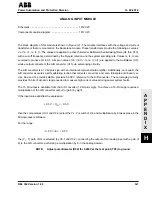
Power Automation and Protection Division
I.L. 40-201.9
REL 352 Version 1.00
H-1
H
A
P
P
E
N
D
I
X
ANALOG INPUT MODULE
Schematic - - - - - - - - - - - - - - - - - - - - - - - - - - - - - - - - 1612C20
Component Location diagram - - - - - - - - - - - - - - - - - - 1611C23
The block diagram of this module is shown in Figure H-1. The module interfaces with the voltage and current
transformers that are mounted on the Backplane module. These transformers provide the following ac values:
V
A
, V
B
, V
C
, I
A
, I
B
, I
C
. The values are applied to active third-order Butterworth antialiasing filters (U8 thru U13),
with a cut-off frequency determined by the Nyquist criterion and the system sampling rate. Values I
A
, I
B
, I
C
are
summed to produce 3I
0
in U5. All seven values (V
A
, V
B
, V
C
, I
A
, I
B
, I
C
, 3I
0
) are applied to the multiplexer (U5),
whose output connects to the A/D converter (U15) via autoranging circuitry.
The A/D converter is a 12 bit plus sign with an internal sample-and-hold amplifier. Additionally, on request, the
A/D converter executes a self-calibrating routine that corrects zero errors and, also, full-scale and linearity er-
rors. Device U16 provides stable, precision 5.000 V reference to the A/D converter. The autoranging circuitry
provides 16 bits of dynamic range needed to measure high current values during power system faults.
The 13 bit output is available from the A/D converter (12 bit plus sign). To achieve a 16-bit range requires a
multiplication of the A/D converter output (or gain) by eight.
If the input value satisfies the expression:
+ 0.5 V < V
IN
< - 0.5 V
then the comparators (U3.1 and U3.2) select the Y
0
- Y) switch of U4, and multiplication by 8 takes place in the
Microprocessor software.
For the range:
- 0.5 V < I
IN
< + 0.5 V
the (Y
1
- Y) path of U4 is selected (by U3.1 and U3.2), connecting the output of U2 (analog input with a gain of
8) to the A/D converter, performing a multiplication by 8 in the analog domain.
NOTE:
Adjust potentiometer (R59) for 5.000V at the test point (TP2) to ground.
















































